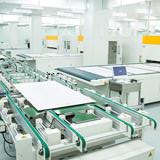

Silk screen production consists of five major elements, namely screen printing plates, squeegees, inks, printing tables and substrates.
The basic principle of silk screen printing is to use the basic principle of the screen printing plate to penetrate the ink, and the non-image part of the mesh is not transparent. During printing, ink is poured into one end of the screen printing plate, and a certain pressure is applied to the ink portion on the screen printing plate by the squeegee blade while moving toward the other end of the screen printing plate. The ink is squeezed from the mesh of the graphic portion onto the substrate by the squeegee during movement. Due to the viscosity of the ink, the print is fixed within a certain range. During the printing process, the squeegee is always in line contact with the screen plate and the substrate, and the contact line moves as the squeegee moves. Since the screen printing plate and the substrate maintain a certain gap, the screen printing plate at the time of printing generates a reaction force against the squeegee by its own tension, and this reaction force is called a resilience force. Due to the resilience, the screen printing plate and the substrate are only in mobile line contact, and the screen printing plate is not smog, and the ink and the screen are broken, ensuring printing. Dimensional accuracy and avoiding sheet metal dirty substrates. When the squeegee scrapes across the entire layout, it is lifted, and the screen plate is lifted, and the ink is gently scraped back to the original position. This is a printing trip.
Tel:15158365810
HTML:www.mysyqc.com
Add:No.185, bridge 3 road, xiaoqiaotou village, qiaotou town, cixi city